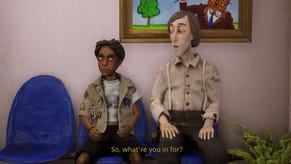Wot I Think: Parallax
Black And White Thinking
As first-person puzzle games get more complicated, we have two choices as a species. To develop mightier, more powerful brains than ever before, or to just try not to think too hard and hope it works out. After the Digipen team that brought us Narbacular Drop opened up very apposite portals in our minds, the genre has run with it, leading to the brain-straining likes of Infinifactory, Void, Antichamber, Standpoint, The Talos Principle and Mind: Path To Thalamus. And as the concepts get more complex, the contortions our brains need to achieve get bendier.
I think Parallax [official site] might have given my brain a nasty sprain.
In Parallax's puzzles, round portal-like doorways lead to an alternate reality version of the same level. But they only lead there in one direction - from the other side, the doorway sports a big "X". Until you go through one, and then the Xd sides of the doorways become open, and vice versa. And the floors change. In parts. But you can press switches to change which way around the doorways face. And so, can you then work out a route through them such that if you go through the first, into the negative-version of reality, you'll then be able to access the second? And what about that launching ramp? If you reverse the door in this realm, but then jump there, will the portal be open the other way to reach the switch to rotate the section of barrier? And at this point I find myself choosing to solve the puzzles by pure instinct, rather than trying to maintain two versions of reality in my brain at the same time. That only works for so long, however.
It's very beautifully presented, in stark, crisp black and white, the two realities a negative of each other. It creates a crisp, extremely attractive design, and is surprisingly clear at distinguishing the two versions of each level. The music is appropriately minimalist, the sound effects quickly communicative. There's much to praise about its presentation.
And in those early levels, Parallax really works. It's definitely complicated, but the mental juggling is achievable. Working out how to manipulate four or five portals, spin a couple of platforms, and leap back and forth between realities, feels very satisfying. But extremely quickly, for me, the game gets in a tangle. By the 17th level of 32, the levels are such a twisting labyrinth of switches, doorways and platforms, in two alternate realities, that the only way to approach solving them becomes trial and error. Hit this button, see what it does to this platform, how it affects those portals, and then step through that one and see if there's now a path to that switch... And for a game that measures your performance in a level by how many switches you press, it seems to contradict its own ethos in forcing this experimentation.
Of course, solving by experimentation in interesting first-person puzzles is no bad thing. The Talos Principle does this better, more tightly, than anything else in recent memory, giving you a limited set of tools, and asking you to stretch their use beyond what feels possible. But Parallax goes the opposite way. It gives you no tools but a multitude of directions to go in, a lot of choice about the order in which you try everything, and in doing so, it feels too loose. To me, at least.
It's obvious that puzzle style is very much based on personal taste, and looking around at comments about the game, there are people delightedly perfect-ing every level. Perhaps they're simply a lot smarter than me, able to manage more details in their heads at one time, seeing pathways where I just see jumble. Or perhaps they're very patient. I believe puzzles should either have discernible routes to be fathomed, or should provide a more meaningful space for experimentation (and then not discourage it in the scoring). For me, Parallax quickly has neither. But again, with the caveat that maybe I'm a big ol' thicko.
The issue is, after finally stumbling my way through a level, by luck or persistence, the start of the next is even less welcoming. By levels 17 and 18, I stare at the extremely nicely presented ludicrous maze and feel no will in my spirit to start them.
At £6.30, clearly this is cheap enough for you to pooh-pooh at my feckless ways and see if you're a better person. I hope you are, as puzzles this involved and complicated will likely please the pan-dimensional minds for whom they're built. I like a bit more structure, a greater sense of perceiving a route and then pursuing it. You may disagree. We should fight.












